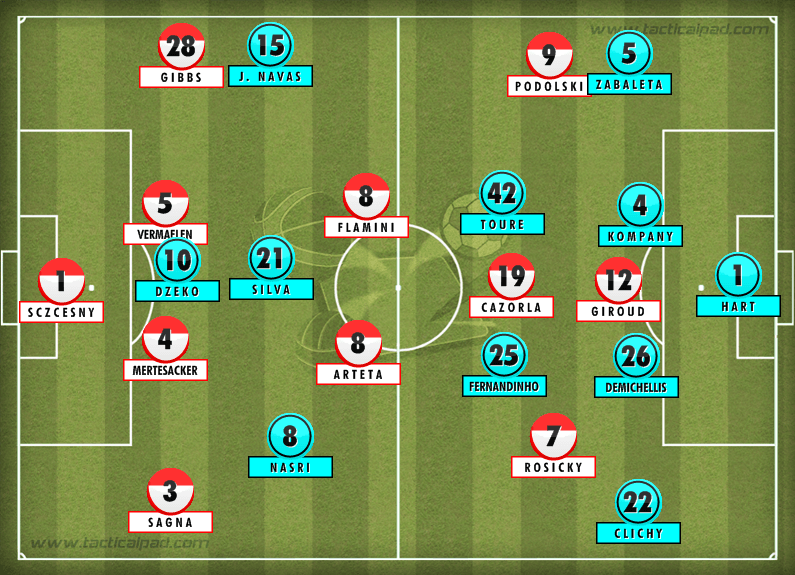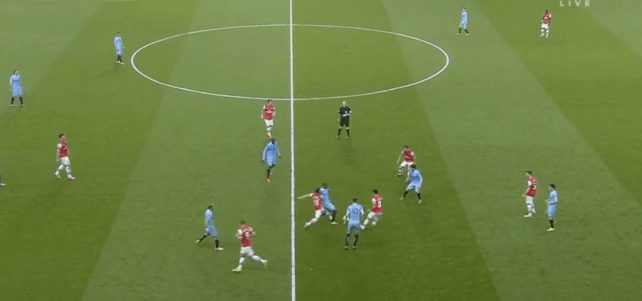A crucial game for both teams, with Man City needing to win to go top after Chelsea losing at Palace, and Arsenal needing three points to maintain their chase for 4th, which has recently been blown open, with Everton picking up 12 points out of their last six games, and Arsenal just 8. Both teams enter the game on the back of a contrast in results, City brushing aside local rivals in a game where other than brief periods they looked very unlikely to lose, easily dominating in central areas against a frustrated United who struggled to penetrate. Arsenal drawing with Swansea, after the humiliating game against title contenders Chelsea, meaning losing the game would surely rule out any chance of winning the league.
Line Ups
Arsenal: Sczcesny; Sagna; Mertesacker; Vermaelen; Gibbs; Arteta; Flamini; Cazorla; Rosicky; Podolski; Giroud.
Manchester City: Hart; Zabaleta; Kompany; Demichellis; Clichy; Toure; Fernandinho; Nasri; Silva; Navas; Dzeko.

Made using Tactical Pad
Analysis
Arsenal fail to deal with Silva
During the first half, City’s dominance in possession was apparent, but also able to penetrate Arsenal’s midfield line easily through combinations with Silva who shone throughout. Wenger, who had left Flamini on the bench for the Chelsea game, chose to start the holding midfielder, but he offered little protection early on. Arsenal without the ball became passive, and Silva frequently received the ball between the lines with little pressure, and often pressed by a centre back, causing problems with leaving Dzeko 1v1. Silva frequently peeled wide, combining with full backs and wingers which Arsenal struggled to deal with, despite the option of always playing Flamini deeper to mark him tighter. In the first goal Silva receives the ball behind Flamini, which with the advancing full backs failing to recover quick enough effectively creates the chance. The failure to deal with him is even more surprising when you look at his influence in the Manchester derby.
City’s high press
Throughout the first half, City adopted a high press strategy, which frustrated Arsenal who were unable to play out. Giroud’s lack of pace means there was little chance of Arsenal penetrating in behind, meaning one centre back could always mark tight, and City were able to squeeze the play, knowing there would be little danger exploiting in behind. When in possession, City would often play in confined areas, making winning possession back far easier when they lost it. The picture below showing City attempting to win possession soon after loosing it, with 6 players around the ball, often Nasri would narrow even more than shown to again make it difficult to play out. Moving Podolski central or the introduction of Oxlade-Chamberlain would have perhaps give City more of a problem, with Giroud managing just one attempt in the first half.
Zabaleta exploiting Podolski
During the first half, the majority of City’s success game from the right hand side, with Zabaleta advancing frequently, with very little pressure from Podolski, and frequently creating 2v1s with Navas, whose width provided even more space for Silva, which meant combination play in wide areas became easy, causing Gibbs problems without the ball.
Arsenal revitalised second half
Despite behind dominated in the opening 45 minutes, Arsenal were able to stay in the game, and an early goal in the second half provided the home side a lift. Gibbs and Podolski who had became overrun out of possession, saw success with the ball, with a cross from this channel resulting in the first goal. This soon prompted the introduction of James Milner, offering a more structured aspect to City’s play. Arsenal were able to break lines quicker in the middle by moving the ball faster, partly due to the drop in performance from City as well as improvement from Cazorla, Flamini and Arteta who were able to combine far more effectively. Flamini played far more advanced as stats show.

Flamini’s first half action areas.
via squawka.com

Flamini’s action zones in the second half.
via squawka.com
Where does this leave them?
In an exciting game with a contrast in both 45 minutes, a draw was probably a fair result, with both sides dominance in each half effectively being matched on the scoreboard. For City, a draw means the title race remains a battle between three. Arsenal who are now surely ruled out have a battle for fourth, 1 win the the last 5 matches means Everton and Spurs are able to offer competition for the final Champions League place until the end of the season.
This article was written by Jack Radusin. Follow him on Twitter at @JRadusin
For more Tactical Analysis of the biggest games across Europe, head this way.






























































